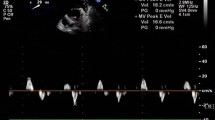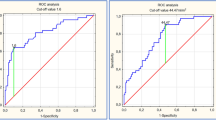Abstract
Epicardial adipose tissue (EAT) is associated with the development of atrial fibrillation (AF). EAT thickness identified on transthoracic echocardiography (TTE). The relationship between EAT volume and left atrial appendage (LAA) function is not well-known. We aimed to investigate the associations between EAT thickness and LAA emptying flow velocity and LAA orifice area. This single-center retrospective study enrolled 202 patients who underwent both TTE and transesophageal echocardiography (TEE). EAT thickness was measured on TTE in parasternal long-axis view. We measured LAA orifice areas in 41 patients with 3-dimensional TEE data. Spearman’s correlation coefficient was used to determine the relationships between EAT thickness and LAA emptying flow velocity and LAA orifice area. We created a receiver operating characteristic curve for low LAA emptying flow velocity (< 20 cm/s) and determined the best cutoff for EAT thickness according to the maximum Youden index. There was a significant negative correlation between EAT thickness and LAA emptying flow velocity (ρ = − 0.56, P < 0.001) and a significant positive correlation between EAT thickness and LAA orifice area (ρ = 0.38, P = 0.014). The best EAT thickness cutoff value for low LAA emptying flow velocity was > 5.1 mm (c-statistics, 75.7%). A thickened EATT was associated with low LAA emptying flow velocity, which increases the risk of thromboembolic phenomena in the presence of AF.






Similar content being viewed by others
References
Talman AH, Psaltis PJ, Cameron JD, Meredith IT, Seneviratne SK, Wong DT (2014) Epicardial adipose tissue: far more than a fat depot. Cardiovasc Diagn Ther 4:416–429
Mazurek T, Zhang L, Zalewski A, Mannion JD, Diehl JT, Arafat H et al (2003) Human epicardial adipose tissue is a source of inflammatory mediators. Circulation 108:2460–2466
Shimabukuro M, Hirata Y, Tabata M, Dagvasumberel M, Sato H, Kurobe H et al (2013) Epicardial adipose tissue volume and adipocytokine imbalance are strongly linked to human coronary atherosclerosis. Arterioscler Thromb Vasc Biol 33:1077–1084
McClain J, Hsu F, Brown E, Burke G, Carr J, Harris T et al (2013) Pericardial adipose tissue and coronary artery calcification in the multi-ethnic study of atherosclerosis (MESA). Obesity (Silver Spring) 21:1056–1063
Wong CX, Abed HS, Molaee P, Nelson AJ, Brooks AG, Sharma G et al (2011) Pericardial fat is associated with atrial fibrillation severity and ablation outcome. J Am Coll Cardiol 57:1745–1751
Thanassoulis G, Massaro JM, O'Donnell CJ, Hoffmann U, Levy D, Ellinor PT et al (2010) Pericardial fat is associated with prevalent atrial fibrillation: the Framingham Heart Study. Circ Arrhythm Electrophysiol 3:345–350
Samanta R, Pouliopoulos J, Thiagalingam A, Kovoor P (2016) Role of adipose tissue in the pathogenesis of cardiac arrhythmias. Heart Rhythm 13:311–320
Oba K, Maeda M, Maimaituxun G, Yamaguchi S, Arasaki O, Fukuda D et al (2018) Effect of the epicardial adipose tissue volume on the prevalence of paroxysmal and persistent atrial fibrillation. Circ J 82:1778–1787
Hatem SN (2014) Is epicardial adipose tissue an epiphenomenon or a new player in the pathophysiology of atrial fibrillation? Arch Cardiovasc Dis 107:349–352
Stoddard MF, Dawkins PR, Prince CR, Ammash NM (1995) Left atrial appendage thrombus is not uncommon in patients with acute atrial fibrillation and a recent embolic event: a transesophageal echocardiographics tudy. J Am Coll Cardiol 25:452–459
Yaghi S, Song C, Gray WA, Furie KL, Elkind MS, Kamel H (2015) Left atrial appendage function and stroke risk. Stroke 46:3554–3559
Mügge A, Kühn H, Nikutta P, Grote J, Lopez JA, Daniel WG (1994) Assessment of left atrial appendage function by biplane transesophageal echocardiography in patients with nonrheumatic atrial fibrillation: identification of a subgroup of patients at increased embolic risk. J Am Coll Cardiol 23:599
Iacobellis G, Assael F, Ribaudo MC, Zappaterreno A, Alessi G, Di Mario U et al (2003) Epicardial fat from echocardiography: a new method for visceral adipose tissue prediction. Obes Res 11:304–310
Iacobellis G (2008) Echocardiographic epicardial fat: a new tool in the white coat pocket. Nutr Metab Cardiovasc Dis 18:519–522
Eroglu S (2015) How do we measure epicardial adipose tissue thickness by transthoracic echocardiography? Anatol J Cardiol 15:416–419
Malavazos AE, Di Leo G, Secchi F, Lupo EN, Dogliotti G, Coman C et al (2010) Relation of echocardiographic epicardial fat thickness and myocardial fat. Am J Cardiol 105:1831–1835
Yun KH, Rhee SJ, Yoo NJ, Oh SK, Kim NH, Jeong JW et al (2009) Relationship between the echocardiographic epicardial adipose tissue thickness and serum adiponectin in patients with angina. J Cardiovasc Ultrasound 17:121–126
Lang RM, Badano LP, Mor-Avi V, Afilalo J, Armstrong A, Ernande L et al (2015) Recommendations for cardiac chamber quantification by echocardiography in adults: an update from the American Society of Echocardiography and the European Association of Cardiovascular Imaging. J Am Soc Echocardiogr 28:1–39e14
Bansal M, Kasliwal RR (2012) Echocardiography for left atrial appendage structure and function. Indian Heart J 64:469–475
Fatkin D, Kelly RP, Feneley MP (1994) Relations between left atrial appendage blood flow velocity, spontaneous echocardiographic contrast and thromboembolic risk in vivo. J Am Coll Cardiol 23:961–969
Lowe BS, Kusunose K, Motoki H, Varr B, Shrestha K, Whitman C et al (2014) Prognostic significance of left atrial appendage "sludge" in patients with atrial fibrillation: a new transesophageal echocardiographic thromboembolic risk factor. J Am Soc Echocardiogr 27:1176–1183
Spencer RJ, DeJong P, Fahmy P, Lempereur M, Tsang MYC, Gin KG et al (2015) Changes in left atrial appendage dimensions following volume loading during percutaneous left atrial appendage closure. JACC Cardiovasc Interv 8:1935–1941
Shah SJ, Bardo DM, Sugeng L, Weinert L, Lodato JA, Knight BP et al (2008) Real-time three-dimensional transesophageal echocardiography of the left atrial appendage: initial experience in the clinical setting. J Am Soc Echocardiogr 21:1362–1368
Nucifora G, Faletra FF, Regoli F, Pasotti E, Pedrazzini G, Moccetti T et al (2011) Evaluation of the left atrial appendage with real-time 3-dimensional transesophageal echocardiography: implications for catheter-based left atrial appendage closure. Circ Cardiovasc Imaging 4:514–523
Sommer M, Roehrich A, Boenner F, Aissa J, Kropil P, Antoch G et al (2015) Value of 3D TEE for LAA morphology. JACC Cardiovasc Imaging 8:1107–1110
Shmilovich H, Dey D, Cheng VY, Rajani R, Nakazato R, Otaki Y et al (2011) Threshold for the upper normal limit of indexed epicardial fat volume: derivation in a healthy population and validation in an outcome-based study. Am J Cardiol 108:1680–1685
Fawcett T (2006) An introduction to ROC analysis. Pattern Recogn Lett 27:861–874
Ruopp MD, Perkins NJ, Whitcomb BW, Schisterman EF (2008) Youden Index and optimal cut-point estimated from observations affected by a lower limit of detection. Biom J 50:419–430
Koo TK, Li MY (2016) A guideline of selecting and reporting intraclass correlation coefficients for reliability research. J Chiropr Med 15:155–163
Tsao HM, Hu WC, Tsai PH, Lee CL, Liu FC, Wang HH et al (2016) The abundance of epicardial adipose tissue surrounding left atrium is associated with the occurrence of stroke in patients with atrial fibrillation. Medicine (Baltimore) 95:e3260
Bunch TJ, Crandall BG, Weiss JP, May HT, Bair TL, Osborn JS et al (2011) Patients treated with catheter ablation for atrial fibrillation have long-term rates of death, stroke, and dementia similar to patients without atrial fibrillation. J Cardiovasc Electrophysiol 22:839–845
Funding
This study did not receive any specific grant from funding agencies in the public, commercial, or not-for-profit sectors.
Author information
Authors and Affiliations
Contributions
SY originated the concept of this study; YO, BT, JF, DB, and DD measured epicardial adipose tissue volume by computed tomography; SY, JY, HI, and ST deeply discussed the result of this study; SY and JY evaluated the epicardial adipose tissue thickness in transthoracic echocardiography; and ST supervised all aspect of this study.
Corresponding author
Ethics declarations
Conflict of interest
The author declared no conflicts of interest.
Additional information
Publisher's Note
Springer Nature remains neutral with regard to jurisdictional claims in published maps and institutional affiliations.
Electronic supplementary material
Below is the link to the electronic supplementary material.
Rights and permissions
About this article
Cite this article
Yamaguchi, S., Otaki, Y., Tamarappoo, B. et al. The association between epicardial adipose tissue thickness around the right ventricular free wall evaluated by transthoracic echocardiography and left atrial appendage function. Int J Cardiovasc Imaging 36, 585–593 (2020). https://doi.org/10.1007/s10554-019-01748-w
Received:
Accepted:
Published:
Issue Date:
DOI: https://doi.org/10.1007/s10554-019-01748-w




